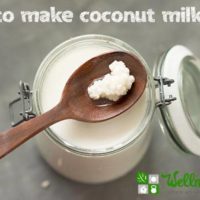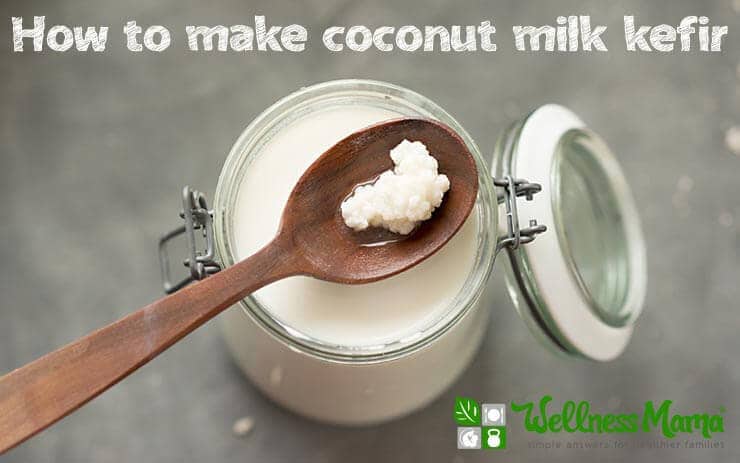I love the taste of regular dairy milk, but unfortunately, my skin does not and I often break out after eating or drinking too much dairy. Fortunately, I love coconut even more and have recently begun experimenting with ways to make delicious and probiotic rich kefir out of coconut milk instead of dairy milk.
After some trial and error (lots of error actually), I finally have a recipe I like, though I do rest the kefir grains in regular dairy milk every few batches to keep them strong.
I also figured out a faster (almost cheating) way to make it using pre-made water kefir (see below the recipe for the variation).
What is Milk Kefir?
Milk kefir is a fermented beverage that is teeming with probiotics and beneficial enzymes. It uses kefir grains (not an actual grain) to ferment milk, making it a liquid yogurt type beverage.
Typically, it is quite tangy, since the fermentation process removes most of the lactose (milk sugar).
Coconut Milk Kefir
Like regular milk kefir, coconut milk kefir is made by using milk kefir grains to ferment the coconut milk, but of course it is dairy free. Coconut milk kefir also has a much milder and less-tangy taste than traditional milk kefir, which makes it a good choice, even for those who aren’t dairy free.
Since coconut milk does not contain lactose like regular milk does, there are a few modifications that should be made to keep the kefir grains strong. I asked my friend Hannah of Kombucha Kamp to answer some of the most commonly asked questions about making coconut milk kefir. Check those out below the recipe!

Coconut Milk Kefir Recipe
Servings
Ingredients
- 2-4 TBSP milk kefir grains
- 2 13.5 oz cans coconut milk
Instructions
- Place the milk kefir grains and the coconut milk in a half gallon glass mason jar.
- Cover lightly and leave at room temperature (70-75°F) for at least 12 hours.
- After 12 hours, start tasting the kefir until it reaches desired level of fermentation.
- Strain out the milk kefir grains and add new coconut milk to repeat the process.
- Store the fermented coconut milk kefir in the refrigerator until you drink it.
Nutrition
Notes
Kefir FAQs with Hannah
Is it possible to make kefir with coconut milk instead of dairy milk?
Milk kefir is the original kefir! A closely guarded secret for generations, it was handed down from family to family as part of the woman’s dowry. “Kef” means to “feel good” in Turkish and like all things that make you feel good, it is hard to keep them a secret forever. That is good news for us bacteriosapiens because kefir is one of the easiest to prepare and most microbially diverse drinks that not only tastes great but keeps everything in good working order.
Many avoid dairy these days unless it is fermented due to issues with lactose intolerance. Without the presence of the bacteria in either raw milk or fermented dairy products, many people experience physical discomfort with symptoms that range from gas and flatulence to diarrhea – yuck! Fermented milk products are easier to digest and offer increased bioavailability of nutrients such as calcium, phosphorus, and magnesium.
So while dairy milks (cow, goat, sheep) are going to provide the best substrate for proliferating kefir grains, for those who avoid dairy, we can also use them to ferment nut milks! Almond and cashew are the most popular nut-milks and are readily available from health and ethnic food stores (come on, it’s the 21st century, you can find anything on the internet!).
Traditionally nuts, seeds, and legumes were sprouted – that is soaked in water to activate germination – in order to deactivate anti-nutrients (such as phytic acid) that protect the seed yet have a negative impact on the human body when consumed in quantity. Many ancient food preparation traditions have been proven through modern scientific study to demonstrate that these techniques evolved not only to improve the flavor but also to facilitate the digestive system in processing and assimilating nutrients. Now add in the beneficial bacteria in the kefir grain to the nut milk and blammo! you’ve got a powerhouse of nutrition right on your kitchen counter.
Another popular type of “milk” to ferment with kefir grains is coconut milk. Technically a drupe (like cherries and peaches), coconuts do not contain phytic acid and do not need to be processed to assist with digestion as the meat is traditionally eaten raw. However, that meat can be processed into a delicious “milk” that is flavorful and full of healthy fats, minerals, and acids like caprylic acid (good for candida sufferers).
Coconut milk has a rich, luscious texture due to its high fat content that yields a tangy and richly satisfying kefir depending on how long it is permitted to ferment. In our experiments, we found that after 3 days, 2 cups of coconut milk with 1 Tablespoon of kefir grains had a refreshing, lightly tangy aroma. Allowing it to ferment a little longer (4-8 days) results in a creamier texture, but also has a pronounced pungency which will enthrall some and repulse others – trust YOUR gut!
Are there any adjustments when making coconut milk kefir?
Kefir grains have evolved with dairy milks. While their fermentation technology can be applied to other non-dairy substrates, the grains will atrophy and die over time. This is because they require lactose, milk sugar, in order to thrive. The grains will continue to work and ferment for many batches, but they will change shape, losing the crispness of their cauliflower shape, turning mushy and grainy over time. The grains may also break off into smaller pieces which may then be lost in the sieve. Nut milks do not demonstrate proliferation over time, though slight plumping may be observed after the first batch or two.
To help maintain the integrity of the kefir grains over time, rest them in dairy milk for at least 24 hours every other batch or two. They may not proliferate at this rate but at least they will have structural integrity. For those who are particularly sensitive to dairy milk, rinse the grains in non-dairy milk or water prior to using again in coconut or other nut milks to remove any traces of lactose or casein.
We found that it took around 7 weeks of regular fermentation in dairy milk to fully recover milk kefir grains so that they would reproduce after having been used to ferment coconut milk for 2 weeks. We recommend using extra grains to ferment coconut milk while maintaining a set exclusively in dairy milk for the purpose of propagation.
Can homemade coconut milk work for kefir?
So which coconut milk yields the best kefir? Our recommendation to yield a product that is delicious yet affordable is to use organic, canned coconut milk. Homemade coconut milk may also be used, but since it is cost and labor intensive, you may simply wish to consume that fresh. As always, the better quality ingredients used, the better tasting the end product; so if you have homemade coconut milk that you would like to use, then by all means do so!
How to care for kefir grains if you go out of town or want to take a break?
In our fast paced 21st century lifestyle, it can be onerous to keep up with ferments that require attention on a daily (or every other day) basis. Its easy to rest the grains for a period of time in the fridge but the longer they are left in the fridge, the longer the rehabilitation time.
1-7 days : Place the grains in a glass and just cover with milk. Store in the refrigerator.
7-14 days: Place the grains in a glass. Leave them dry (no liquid). Store in the refrigerator.
14+ days: Lay kefir grains out on a cookie sheet or dehydrator sheet. Dehydrate at 98-105F until dry. Store dehydrated grains in freezer safe bag in the freezer.
The longer the grains starve or sleep, the longer it may take to revive them. The revived grains will also not have the same bacteria diversity but it will regain diversity as they are woken up and used again.
How to Revive Milk Kefir Grains:
To revive them, place the grains in a small dish and just cover with milk and 1 teaspoon of sugar. Replace the milk every 48-72 hours until the milk begins to separate into whey (clear liquid on the bottom). Once signs of fermentation return, then start a batch using 1 tablespoon of grains for every 2 cups of milk. It may take several weeks before the milk kefir grains regain their full strength and reproduce again.
How to Make Milk Kefir with Pre-made Water Kefir
When someone left a comment on my water kefir post asking if it was possible to use the same grains to make milk kefir, I figured I’d give it a try. My attempts failed and eventually killed my water kefir grains. But one day while making regular coconut milk kefir, I accidentally dumped my water kefir grains (instead of the milk kefir grains) and about ¼ cup of pre-made water kefir into the wrong container.
I strained out and rinsed the grains and they were fine, but since I’d already dumped the finished water kefir into the coconut milk, I decided to let it ferment and see what happened. I let it sit for 12 hours and it appeared to be fermenting, so I left it for 24 hours. The finished product was very similar to making coconut milk kefir with milk kefir grains and I’ve occasionally re-tested this method on purpose with the same results.
What is fermenting in your kitchen right now? Ever made kefir?


Leave a Reply